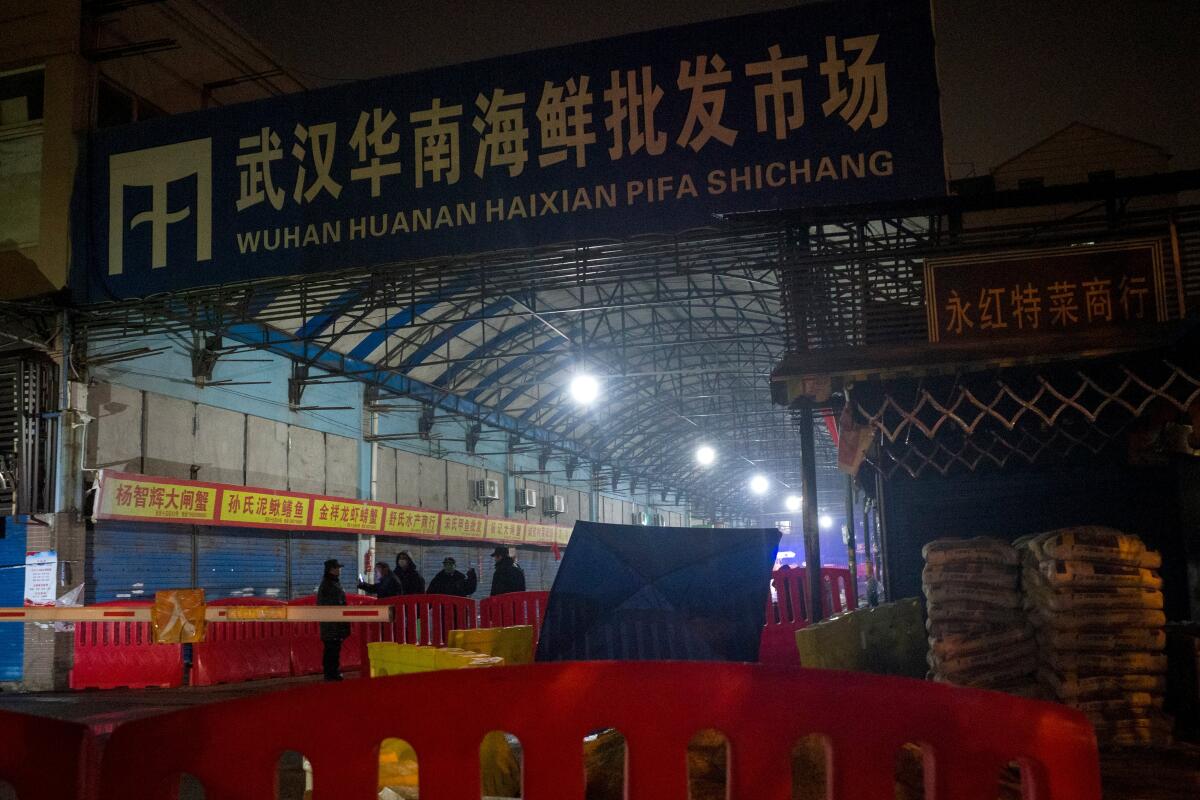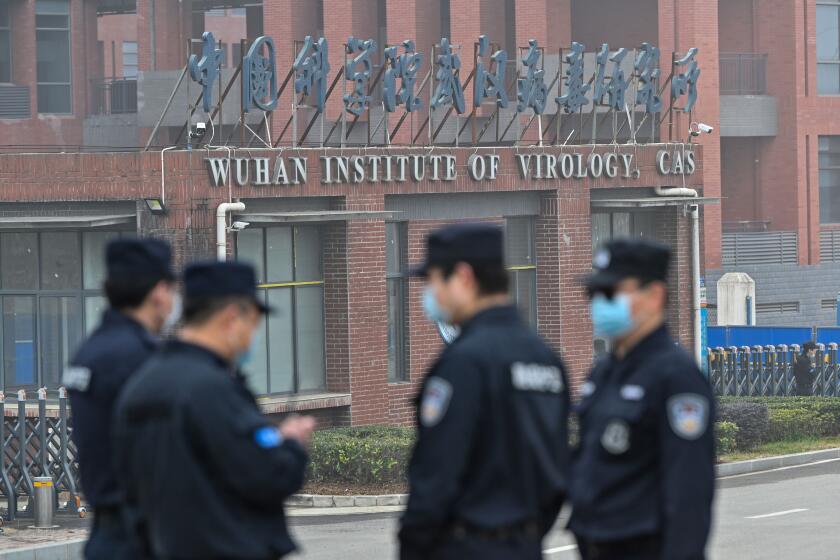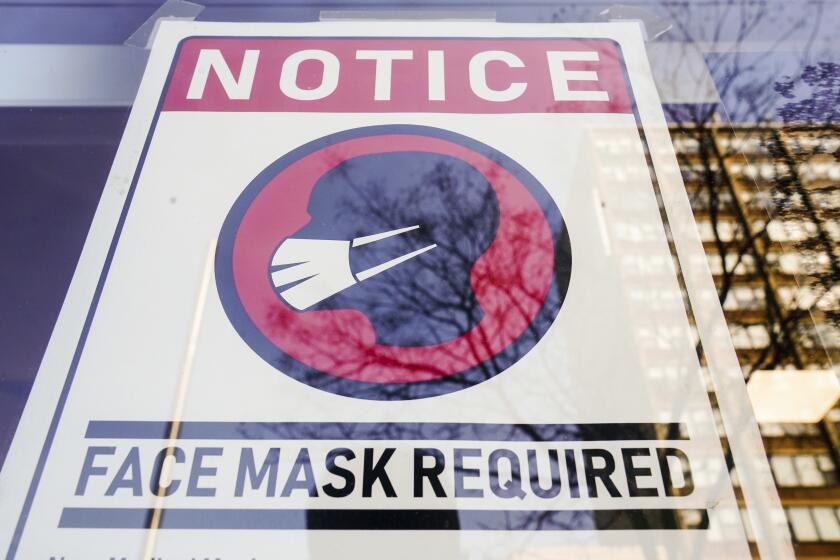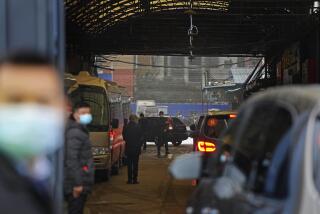Opinion: I called for more research on the COVID ‘lab leak theory.’ Here’s what I found out

- Share via
Recent reports that Department of Energy and FBI officials think the COVID-19 pandemic originated with a so-called lab leak appear to have provided all the “evidence” many require. As a scientist who has led or contributed to several peer-reviewed studies that tell a very different story, I’ve looked on with amazement at the growing divide between what the science shows and what much of the public — and a minority of the intelligence community — believe. But I’ve also watched with understanding for those who still suspect a lab leak because I started there myself.
The nucleus of all lab leak conjectures — they are not a single hypothesis but a wide range of sometimes mutually exclusive speculations — was famously captured by the comedian Jon Stewart. “Oh, my God, there’s a novel respiratory coronavirus overtaking Wuhan, China — what do we do?” Stewart said during a June 2021 appearance on “The Late Show With Stephen Colbert.” “Oh, you know who we could ask: the Wuhan Novel Respiratory Coronavirus Lab. The disease is the same name as the lab!”
Stewart didn’t have the name right, but he was referring to the work of the Chinese scientist Shi Zhengli, whose lab at the Wuhan Institute of Virology does indeed study SARS-related coronaviruses from horseshoe bats, the ultimate reservoir of both the original SARS virus and SARS-CoV-2, the virus that causes COVID-19.
The month before Stewart’s tirade, Science published a letter by me and several other scientists arguing that lab leak hypotheses must not be prematurely dismissed. The letter dramatically shifted the debate about where COVID came from; two weeks later, the Biden administration announced a 90-day intelligence community review of the pandemic’s origins.
While the intelligence community did its work, I set about my own. Though I considered a lab leak plausible, I nevertheless thought a zoonotic origin — a jump from animal to human — to be considerably more likely. Around the same time, the likelihood of a natural origin was bolstered by a paper from scientists in China and Britain proving that live specimens of mammal species previously found to harbor SARS viruses had been sold at markets in Wuhan just before the onset of the pandemic.
The U.S. Department of Energy has assessed with “low confidence” in that the COVID-19 pandemic began with a lab leak, according to a person familiar with a new government report.
A scientist’s job is to kick the tires of a hypothesis — to try to falsify it. I tabled all my other research to try to falsify the hypothesis that the pandemic began at one of those markets, the Huanan Seafood Wholesale Market, where many of the earliest known COVID patients worked.
First I investigated the possibility that Shi’s lab had possessed a virus close enough to SARS-CoV-2 to be its progenitor. Shi had collected what was at the time the closest known relative of the pandemic virus, known as RaTG13, from a mine in Yunnan province.
I asked Nature to request that Shi publish several SARS-related coronavirus sequences that had been reported in the journal. Within days, she provided them. The result: no smoking gun; they were all much more distantly related to SARS-CoV-2 than RaTG13.
Next I set out to answer another key question: Were so many of the earliest known COVID cases linked to the Huanan market simply because that was where people were searching for them? It had been suggested that the market was the first place where cases were detected because China was focused on markets with live animal sales such as those where SARS appears to have emerged.
This turned out to be dead wrong. No such surveillance of live animal markets occurred in Wuhan prior to the pandemic. Astute doctors recognized the new viral pneumonia before an epidemiological link to the Huanan market emerged. Before that association was made, more than half the early cases diagnosed had a clear link to the market — a huge share for a workplace with about 1,500 employees in a sprawling city of 11 million. Also, both of the earliest two lineages of SARS-CoV-2, designated A and B, appeared to be geographically linked to the market, as I wrote in Science in November 2021.
We may never have a definitive answer to COVID’s origins. Reserve your anger for the way the Trump administration bungled its response to the disease.
But would mapping the residences of the earliest known patients cast doubt on the hypothesis that the market was the epicenter of the pandemic? I found a way to identify most of these locations by overlaying different low-resolution maps from a World Health Organization report. I then teamed up with Kristian Andersen of the Scripps Research Institute, who was leading an independent study of spatial patterns within the Huanan market, and we assembled a large, international team of experts.
We found that the earliest known COVID cases lived much closer to and more centered around the Huanan market than could be explained by chance. Crucially, this was true even of patients who reported that they hadn’t worked at the market, shopped there or knowingly been in contact with anyone who did.
A more scattered distribution of early cases throughout the city would have suggested that the virus was already widespread in December. But the pattern clearly showed that it was only then beginning to bleed into the community surrounding the market and didn’t spread more widely across the city until later.
Our analyses linked the market not only with lineage B, which had already been found there, but also with lineage A, which had not. Just before we first reported these findings in February 2022, George Gao and his colleagues reported that lineage A was indeed present at the Huanan market before it was closed. This shows that the Huanan market wasn’t simply the site of a “superspreader event,” which would have amplified only a single lineage.
Within the market, meanwhile, the surfaces of stalls that sold live mammals or meat were more likely to have tested positive for SARS-CoV-2 just after the site was closed. One stall riddled with positive samples from surfaces associated with animal sales, including a metal cage, had been visited years earlier by my co-author Eddie Holmes of the University of Sydney, who had photographed raccoon dogs there. The same species was among the market animals that tested positive for the SARS virus in 2003.
A highly technical companion study led by UC San Diego’s Jonathan Pekar and Joel Wertheim, along with UCLA’s Marc Suchard, Andersen and me, drew on over 700 of the earliest SARS-CoV-2 genome sequences. The evolutionary trees of these sequences, combined with epidemiological information, shows that the ancestors of lineages A and B almost certainly jumped into the human population separately. We also found that the establishment of these two lineages probably involved about five jumps into individual humans, most of which fizzled out before taking hold. “Molecular clock” analyses indicate that the lineages shared common ancestors that existed around mid-December 2019, corroborating the epidemiological and geographic evidence that the outbreak was largely restricted to the neighborhoods around the Huanan market at that point.
The Wall Street Journal tries to revive the lab leak theory on COVID’s origins as a gift to the GOP, but it’s still nonsense.
The two studies, which were published in Science following peer review last July, provide overwhelming, unrefuted scientific evidence that the virus that causes COVID emerged at least twice at the Huanan market, likely between mid-November and early December of 2019. And while it may strike some as odd that the virus jumped twice in the same market, research on mink farms and the pet trade shows that when SARS-CoV-2-infected animals are in close contact with humans over a prolonged period, multiple interspecies jumps are inevitable.
And as we showed using cellphone-based mobility data, the Huanan market is an exceedingly unlikely location for the world’s first large cluster of COVID cases unless it was also where the virus emerged. There are hundreds if not thousands of other places where hypothetical lab leak cases could have initiated human-to-human transmission — bars, restaurants, schools, shopping malls — some with a hundred times the traffic of the Huanan market. Even one such event at Huanan is deeply improbable; fold in the strong evidence for two lineages emerging at the market, and the link to the wildlife trade is unavoidable.
Remarkably, some recent reporting suggests that the Energy Department’s new “low confidence” lab leak conclusion may point to an entirely different lab near the Huanan market, the Wuhan Center for Disease Control and Prevention, which would directly contradict all the speculation surrounding the Wuhan Institute of Virology.
There is now a large body of peer-reviewed scientific research consistent with a zoonotic origin of this pandemic. However, there is no credible, peer-reviewed research pointing to a lab leak. Had the evidence gone in the other direction, I’d be reporting that. But it hasn’t.
The “evidence” in favor of a lab leak consists fundamentally of discredited talking points. The lack of a positive sample from an animal sold at the Huanan market, for example, supposedly undercuts the market-origin hypothesis. But not a single relevant live animal was tested there before the market was closed.
Lab leak proponents cling to the contention that the presence of a lab that studies viruses and the emergence of a coronavirus pandemic in the same city can’t possibly be coincidental. But my colleagues and I showed in 2021 that this virus wasn’t going to emerge just anywhere in China: It took a city. Simulations indicate that when a virus with the properties of SARS-CoV-2 jumps into a human in a sparsely populated rural area, it will fail to cause an outbreak 99% of the time. But take that same virus into a huge city like Wuhan, and about a third of animal-to-human transmissions will result in an epidemic.
We should instead be asking: What is the chance that a big Chinese city like Wuhan would have a lab doing the kind of research that has come under suspicion? The answer is, the vast majority of the biggest cities in China have labs involved in such research. If COVID had emerged in, say, Beijing, there would be no fewer than four such labs facing suspicion.
I remain open to any and all evidence supporting a laboratory origin of the pandemic. So far, we have no such evidence.
Michael Worobey is a professor and the head of the department of ecology and evolutionary biology at the University of Arizona.
More to Read
A cure for the common opinion
Get thought-provoking perspectives with our weekly newsletter.
You may occasionally receive promotional content from the Los Angeles Times.












